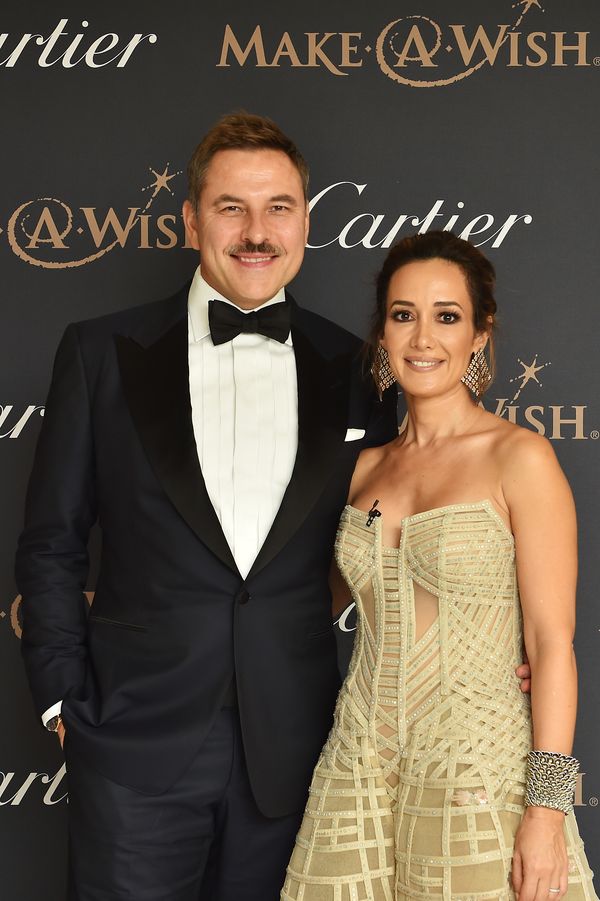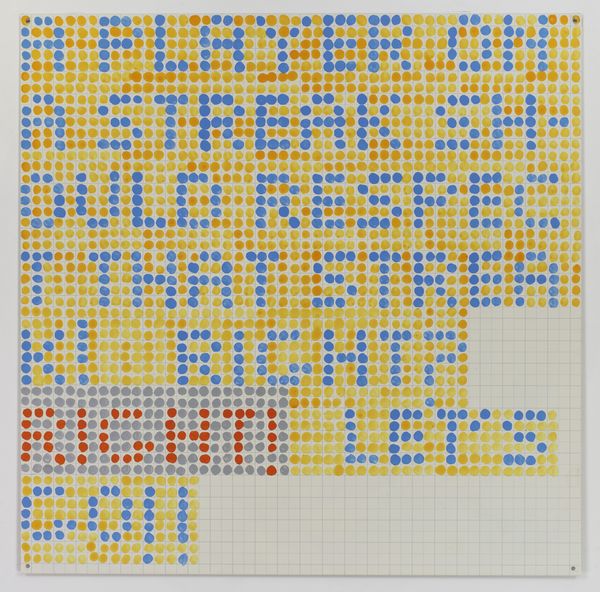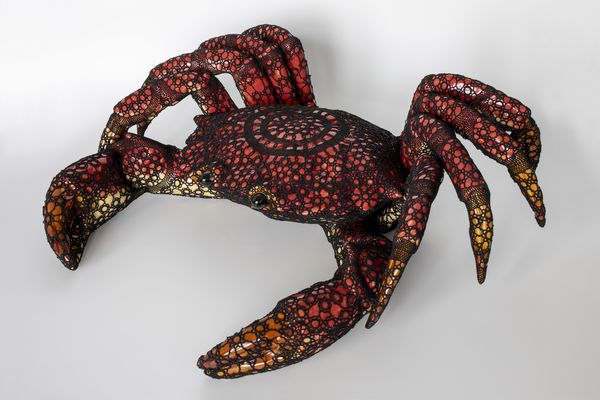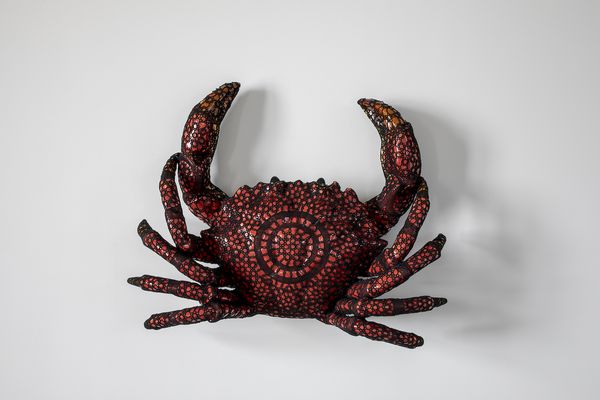Artist Joana Vasconcelos, photo credit: Kenton Thatcher/©Unidade Infinita Projectos
The Art of Wishes Gala Host David Williams OBE and Founder Batia Ofer
On 1 October 2019, children's charity Make‐A‐Wish® UK will present The Art of Wishes Gala, founded by philanthropist and Make‐A‐Wish® UK Patron, Batia Ofer. Timed for Frieze London, the event will take place at the Royal Horticultural Halls and will be hosted by Make‐A‐Wish® UK supporter David Walliams OBE. This year's Gala hopes to surpass the success of the inaugural 2017 event, which raised a phenomenal £2.8million for the life‐changing charity.
Jennifer Bartlett Conversation I, 2005. Courtesy of Marianne Boesky Gallery. To be offered at auction at The Art of Wishes Gala.
In advance of the Gala, a preview of the artworks up for auction will be open to the public at Phillips gallery space on Berkeley Square from 19 to 20 September. More than 20 artworks by leading international artists, including Ai Weiwei, Virgil Abloh x Takashi Murakami, James Turrell, Joana Vasconcelos, Harold Ancart, Michael Craig‐Martin, Annie Morris, A.R. Penck and Jennifer Bartlett, will be included in the charity auction in support of Make‐A‐Wish®. Donated artworks are reflective of children's wishes granted by Make‐A‐Wish® over the past ten years.
A.R. Penck Untitled (Standart), 1967-1968. Courtesy of Michael Werner. To be offered at auction at The Art of Wishes Gala.
Here, Batia Ofer speaks to one of the participating artists, Joana Vasconcelos, on this year's initiative.
BATIA OFER: I first came across your work at the 51st Venice Biennale in 2005 and later in 2012 at the Palace of Versailles, where you were the first woman and the youngest artist to exhibit in its history. From here you have gone on to build a diverse and rich portfolio of installations and exhibitions around the world, including a solo exhibition at the Guggenheim Museum Bilbao. I have been avidly following your work and am particularly drawn in by your ambitious nature, from the scale of your works to the explosion of textures, colors and techniques, often hinting at your Portuguese heritage through the materials you use. How did you nurture this style and how has it developed over recent years?
JOANA VASCONCELOS: To be an artist wasn't a decision but something that happened — and that I embraced. Every day I do my best to answer this calling. I tried out drawing, jewelry, attended various workshops, and with each experience, I gained a fuller notion of the spectrum of possibilities. To be an artist is to assume a very special role relating to the world, and my creative process arises from a critical observation of that which surrounds me. Thus, I'm inspired by quotidian life and contemporary issues and resort to everyday objects and materials due to their impressive potential for meaning. We believe we know them well, but these can acquire a new message when challenged to serve concepts or question the world.
The scale of the works is a consequence of previous decisions, and not a prior aim. In the case of Marilyn, I chose to make a pair of high‐heeled size 36 sandals, to scale, using rice saucepans as material. Here, it was the choice of the material and the production process (multiplication of stainless steel pans and lids) that culminated in an object of this scale. A Noiva [The Bride] (work composed of 14,000 tampons) is a different story, as there is a particular relation with the object that is a chandelier, a grand object by definition, with a close relation to architecture. To make it smaller would be to disfigure it. This use of banal materials and objects, transforming them into works of art, has been a part of what we can call my "formal language" as an artist since the very beginning of my career, and it's natural that Portuguese elements are present, because this is where I live and work. However, the international success of my works demonstrates how this is only but a starting point to more universal themes and thoughts. As in my work, I go from micro to macro.
To be an artist wasn't a decision but something that happened — and that I embraced. Every day I do my best to answer this calling. — Joana Vasconcelos
BO: Your work, most recently with the nine-meter pool installation Gateway in Edinburgh, often pushes the boundaries between art and architecture, exploring people's interaction with art. As a passionate art collector myself, I see how art has a powerful way to inform change and also enhance life through a viewer's interaction and emotive response, which is part of the reason I founded The Art of Wishes. What is your view on the positive impact of art and how is this reflected in your work?
JV: My work has, in general, a very interactive character, and the public's role is very important. More than a mere recipient, the public intervenes in the discourse. It's very interesting to see how people react to my works and understand the various readings that are made over the same piece. I mean for my work to be enquiring and that the questions that may arise will help to broaden the perception and knowledge we have of the world. They don't close themselves to just one discourse or to one interpretation. They are ambiguous and paradoxical, and the richness lies exactly in the multiplicity of possible discourses and interpretations.
On the other hand, I do also work to make people dream, as is the case of the monumental project I have in hand at this time and that I'm working on with Albion Barn. It's an 11‐meter‐tall ceramic pavilion in the shape of a wedding cake, where people will have the opportunity to celebrate ceremonies and climb up the stairs to become the figures at the top — just like in traditional wedding cakes!
Joana Vasconcelos Spinoza, 2019. Courtesy of Fundação Joana Vasconcelos and Albion Barn. To be offered at auction at The Art of Wishes Gala.
BO: Make‐A‐Wish is a charity close to my heart. Ever since I helped grant a wish more than ten years ago, I've seen the profound effect the charity has—not only on the child but their family, too. To raise funds for the charity at The Art of Wishes auction, we spoke about the work you would like to donate and you have generously gifted, Spinoza (2019), in connection to a child's wish for a family holiday on a beach. Can you explain the creative process around this work, including the materials you have used, such as the appropriated ceramics by the nineteenth-century Portuguese artist Rafael Bordalo Pinheiro?
JV: The group of pieces in ceramic and crochet — to which Spinoza belongs — come from the series of works created from a limited set of faience pieces designed by Rafael Bordalo Pinheiro (1846‐1905). The appropriation carried out by me, in the scope of his vast production in ceramic, only includes the naturalistic representation of animals — some of them rendered oversize — whose proximity to Man might generate discomfort, awe or fear: wasps; lizards and snakes; crabs and lobsters; frogs; bull‐heads; donkey‐heads and horse‐heads; wolves; or even cats with an aggressive posture are ambiguously imprisoned/protected by a second skin in crochet‐work. This "second skin" is a technique I've developed at the studio since around 2004, and departs from a composition that is made directly over the pieces, through the union of rosettes of different sizes, forms, textures and patterns. For the most part, I resort to cotton crochets that I order from Pico Island, in the Azores. In this way, I'm keeping this very sophisticated knowledge in its place of origin and also contributing to the local economy.
Joana Vasconcelos Spinoza, 2019. Courtesy of Fundação Joana Vasconcelos and Albion Barn. To be offered at auction at The Art of Wishes Gala.
BO: How do you feel the meanings and significance of Spinoza (2019) have synergy with this child's wish and perhaps your own childhood in Portugal?
JV: Portugal is well-known for its breathtaking beaches and marvelous seafood, and Spinoza represents a crab, rendered to an exaggeratedly oversized scale — the dream of anyone who's a fan of this delicacy, like me! Every Sunday, without exception, my family and I have lunch at a seafood restaurant near our home — regardless of the time of the year. Hopefully, Spinoza will help future children and their families enjoy some well‐deserved sundrenched days that end in lovely feasts!
BO: I am so excited to see Spinoza at auction on 1 October 2019 and the reaction of those coming. How do you feel about being a participating artist at The Art of Wishes, and what other exciting projects can we expect from you in the upcoming months?
JV: I was most honored by the invitation, as I have also assumed the mission to help others make their dreams come true. Fundação Joana Vasconcelos was created with the intent to support those who make art their path, and its main activity is the attribution of scholarships to students in the Arts. Besides the Wedding Cake project I mentioned earlier, I'm also working on a new site‐specific exhibition Valkyrie for the brand new MassArt Museum, in Boston, opening in February 2020. This will be my first solo show in the US.
Learn more about The Art of Wishes Gala here >





